A lot of things run through your mind when you get a new puppy: what kind of dog toys you should buy, how beneficial crate training actually is and if they really need their own bed, among other critical questions. However, perhaps the most important consideration, and certainly the most timely, is the best dog food to feed your new puppy — and what you should avoid.
To help you get started, I spoke to veterinarians about how exactly puppy food differs from adult dog food, including ingredients and portion size, and how to determine which one you should feed them for the best nutritional value. I also got highly-rated, expert-backed recommendations for the best dog food to give your puppy and included options that NBC Select staff feed their own puppies.
SKIP AHEAD What’s the difference between puppy food and adult food? | How I picked the best puppy food | Best puppy food in 2024 | How to shop for puppy food
What’s the difference between puppy food and adult dog food?
Since younger dogs are still growing and developing, puppy-specific foods are specifically made for rapid growth. “Puppy food tends to have higher fat and protein content, which also means it is typically more calorie dense,” says Dr. Nell Ostermeier, a veterinarian and veterinary advisor at Figo Pet Insurance. Compared to adult dog food, puppy food also usually has higher levels of protein and essential nutrients like DHA, calcium and phosphorus, which all help their brain and physical development, according to our experts.
Another differentiator is that puppy food usually has a lower energy density (which is the amount of energy per unit weight of food) because if they get too much energy, they can grow too quickly and develop orthopedic problems, especially large and giant breed dogs, says Dr. Nicole Savageau, a board-certified veterinarian at The Vets, a mobile veterinary service.
Large and giant breed dogs should be on a formula that’s labeled specifically for large and giant breed puppies because they have a slight difference in mineral content and lower energy density (which is the amount of energy per unit weight of food), says Savageau. “If they get an inappropriate amount of calcium or they grow too quickly, it could lead to orthopedic problems,” she says. For giant breed puppies, it is best to consult your veterinarian about which food to choose and how long to feed it before switching to adult, says Ostermeier.
How I picked the best puppy food
One of the most important things to do when you get a new puppy is to create a mealtime routine: “Choose a schedule that is convenient for you and your family so that you can stick to the routine — if you create a routine, the puppies will follow,” says Ostermeier. When shopping for quality puppy food, our experts recommend considering the following factors:
AAFCO nutritional standards: The most important consideration when shopping for puppy food is to ensure it meets the Association of American Feed Control Officials (AAFCO) nutritional standards. The food should have a nutritional adequacy statement on the label that says it is “complete and balanced,” which means it meets or exceeds the AAFCO standards, according to our experts and the World Small Animal Veterinary Association.Ingredients: The ingredients in your puppy’s food are a great way to determine palatability and how much they’ll enjoy it. Ingredients are listed on the packaging from highest to lowest weight, which means the first three are the most crucial to consider, according to AAFCO. All of the puppy food brands we list also have a dedicated team of veterinary nutritionists on staff to regulate the use of high-quality ingredients (AAFCO has safety standards for ingredients used in pet food, and it goes in depth about common pet food labels).Breed and size: You should feed your puppy food that’s specifically labeled for puppies until they reach their adult body weight (typically between 1-1.5 years, according to our experts). Some puppy foods are made for different sized breeds, like small, large and giant breeds, which means the size of the kibble is easier for them to ingest and the formula has different caloric and nutritional value to fit their puppy needs. All of the brands I list are high-calorie options for puppies.Portion size: Look for brands that provide a feeding guide on its packaging to help you determine the appropriate portions for your puppy’s weight and size. “The important thing is whatever puppy food someone chooses, the instructions for how to feed [your puppy] based on their weight will be on the bag itself,” says Savageau.
Best puppy food of 2024
Below, I compiled veterinarian-recommended dog food for puppies, as well as highly rated and NBC Select staff favorites that are in line with our experts’ guidance. All of the following puppy foods meet AAFCO nutritional requirements, have feeding guidelines on their packaging and have a team of veterinary nutritionists on staff to regulate the use of high-quality ingredients.
Best overall puppy food: Hill’s Science Diet Puppy Small Bites Dry Dog Food
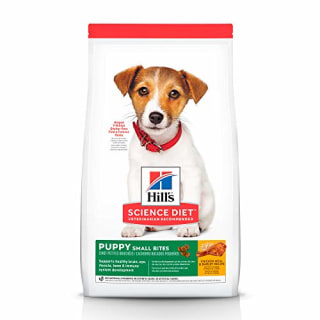
What we like
Source of vitamins/mineralsSmall-sized kibbleEasy to digest
Something to note
Nothing to note at this time
Hill’s Science Diet is one of the top dog food brands among our experts for adult dogs and puppies. One of our favorite dog foods overall, this puppy-specific formula from the brand comes in small, easy-to-digest kibble, according to the brand. It has natural omega-3 fatty acids from fish oil that work to support healthy brain and eye development, and a blend of vitamin E and vitamin C to support a healthy immune system in puppies, according to Hill’s. The food comes in a 4.5-pound or 12.5-pound bag. You can also get the canned version of this puppy food, which you can mix into your dog’s kibble, our experts say.
Food type: Dry | Recommended age: Up to 1 year old | Recommended weight: Up to 120 lbs (expected adult weight) | Calorie content: 393 kcal per cup | Top ingredients: Chicken, brown rice, whole grain wheat
Best budget-friendly puppy food: IAMS Proactive Health Smart Puppy Dry Dog Food
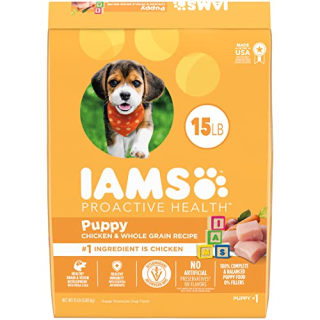
What we like
Good price pointSupports brain/visual health
Something to note
Kibble size larger than others
If you’re on a budget, Iams’ dry puppy food is a highly rated option, with a 4.7-star average rating from over 5,200 reviews on Amazon. Made with chicken and whole grain, this recipe is rich in omega-3 to support mental and visual wellness in puppies, according to the brand.
Food type: Dry | Recommended age: Up to 1 year old | Recommended weight: Up to 50 lbs | Calorie content: 380 kcal per cup | Top ingredients: Chicken, chicken by-product meal, ground whole grain corn
Best wet puppy food: Purina Pro Plan Development Puppy Chicken & Rice Canned Dog Food

What we like
Keeps pups hydratedGreat for all puppy sizesCan mix with kibble
Something to note
Lacks flavor varietyHigher number of calories
Purina Pro Plan is another one of our experts’ favorites, and this canned chicken and rice formula is great for puppies with an expected adult weight of up to 100 pounds, according to the brand. It has essential vitamins and minerals to help keep your puppy’s coat soft and immune system healthy. You can divide the can into three or more feedings for puppies up to 6 months and two feedings from 7-12 months, according to Purina.
Food type: Wet/canned | Recommended age: Up to 1 year old | Recommended weight: 2-100 lbs (expected adult weight) | Calorie content: 475 kcal per can | Top ingredients: Chicken, liver, water, salmon, rice
Best puppy food for small breeds: Royal Canin Small Puppy Dry Dog Food
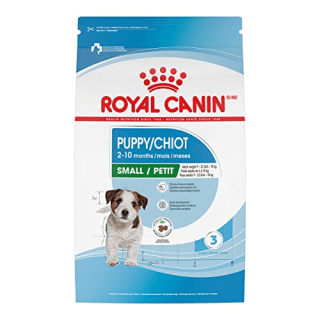
What we like
Small-sized kibbleImmune system and digestionCrunchy texture
Something to note
Expected adult up to 22 pounds
Royal Canin is a favorite among the veterinarians I spoke to, as well as NBC Select staff. I fed my now 6-year-old havanese and bichon frise mix Bella this formula when she was a puppy after it was recommended to me by her vet. I still feed her the adult small breed version of Royal Canin’s dog food — it’s the only kibble that she doesn’t get bored of, and it’s one I constantly come back to whenever I switch it up. Made for dogs up to 22 pounds, the crunchy kibble is bite-sized for small breed puppies and has omega-3 fatty acids and vitamins C and E to support healthy growth and energy levels.
Food type: Dry | Recommended age: 2-10 months | Recommended weight: 9-22 lbs (expected adult weight) | Calorie content: 349 kcal per cup | Top ingredients: Chicken by-product meal, brewers rice, chicken fat, wheat gluten, corn
Best puppy food for large breeds: Purina Pro Plan Large Breed Dry Puppy Food
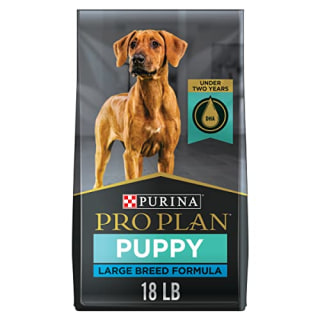
What we like
Made for large breedsSupports brain/visual healthGood for sensitive stomachs
Something to note
Nothing to note at this time
Another vet-recommended brand, Purina Pro Plan has a variety of puppy-specific formulas that focus on different needs and concerns, including options for toy breeds and dogs with sensitive skin and stomachs. This formula from the brand helps large breed puppies develop at a healthy rate, plus has fish oil for healthy brain and visual development, according to the brand. Made for dogs that’ll reach over 50 pounds at maturity, the kibble is also a great size for bigger dogs.
Food type: Dry | Recommended age: Up to 2 years old | Expected adult weight: Over 50 lbs | Calorie content: 419 kcal per cup | Top ingredients: Chicken, rice, corn gluten meal, whole grain corn
Best puppy food for giant breeds: Royal Canin Size Health Nutrition Giant Puppy Dry Dog Food
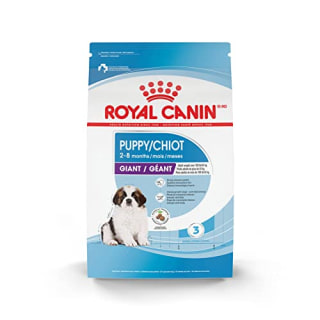
What we like
Made for giant breedsGood ratio nutrients/minerals
Something to note
Own formula for older puppiesHigher price point
Giant dog breeds, such as great danes or saint bernards, will have an adult weight of 100 pounds or over, according to our experts. They need a certain ratio of nutrients and minerals so they don’t grow too quickly (if they do, it could lead to an array of orthopedic problems later in life, according to the vets I spoke to). Royal Canin’s giant breed-specific puppy formula is made for extra-large breed puppies up to 8 months old — once they reach this age, you can switch to Royal Canin Giant Junior formula, which helps support your pup’s muscle development up to 24 months old, according to the brand.
Food type: Dry | Recommended age: 2-8 months | Recommended weight: Over 100 lbs (expected adult weight) | Calorie content: 338 kcal per cup | Top ingredients: Chicken by-product meal, brewers rice, wheat gluten
Best subscription puppy food: The Farmer’s Dog Subscription Dog Food
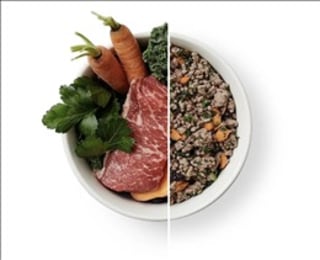
What we like
Subscription planPersonalized planReady-to-eat meals
Something to note
Higher price pointMay need to ease into new diet
The Farmer’s Dog is a subscription dog food service that delivers food for both growing puppies and adult dogs right to your door. Each prepared meal delivery comes with the exact portions your pup needs based on their age, weight breed, activity level and build — you simply fill out a questionnaire before placing your order, and the brand calculates the plan that fits your dog’s calorie and nutritional needs.
NBC Select social commerce editor Sadhana Daruvuri has fed The Farmer’s Dog to her 2-year-old maltipoo Bandit since he was 6 months old. “My dog Bandit has been a picky eater since the day I brought him home — he would sometimes struggle with the kibble I fed him,” says Daruvuri. “As soon as we switched to Farmer’s Dog, I saw a huge change; Bandit would get excited for mealtime and finish all his food in less than a minute.”
All of The Farmer’s Dog’s ready-to-eat meals are developed and reviewed by board-certified veterinary nutritionists to be complete and balanced according to AAFCO standards, according to the brand. You can store the food in the fridge or freezer, and serve it directly from the fridge (or add a touch of hot water if your pup prefers warm food). Plans start at about $2 per day (with free shipping), and you’ll get about one week to two months of food with each delivery.
Food type: Fresh | Recommended age: n/a (based on questionnaire) | Recommended weight: n/a (based on questionnaire) | Calorie content: n/a (based on questionnaire) | Top ingredients: Human-grade (based on questionnaire)
Best fresh puppy food: Just Food for Dogs Puppy Variety Pack
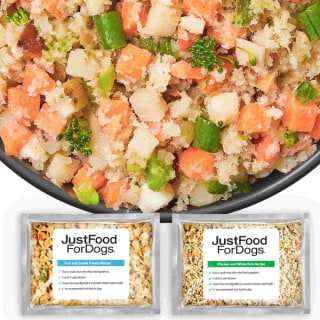
What we like
Pre-cooked ingredientsLast 18 months in freezerCan autoship
Something to note
May need to ease into new diet
“Fresh, gently cooked diets that are nutritionally balanced are just as they sound — they are whole food based and gently cooked,” says Ostermeier. Just Food for Dogs comes recommended by her for growing puppies (as well as pregnant and lactating dogs, according to the brand). The meals are made for all life stages, and they include a feeding guide on the packaging so you know how much to feed your puppy or adult dog. They last up to 18 months in the freezer, and thawed meals stay fresh when sealed in the original package for up to seven days, according to the brand. Once you open the pouch, the brand recommends using it within five days.
Food type: Fresh | Recommended age: All life stages | Recommended weight: Up to 60 lbs | Calorie content: n/a | Top ingredients: Chicken thighs, long-grain white rice, spinach, carrots
Best no-frills puppy food: Nutro Natural Choice Puppy Dry Dog Food
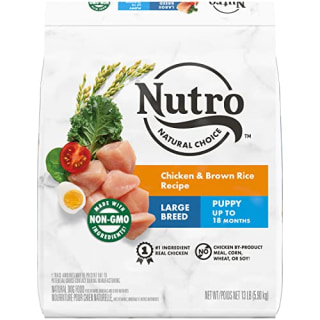
What we like
Supports healthy coat/skinEasy to digestGood price point
Something to note
Kibble is larger than others
Nutro Natural Choice is a favorite of NBC Select editor Jordan Bowman’s 2-year-old mixed pointer Obi. “This is the food he always ate, and it’s helped him be more comfortable in a new home,” he says. The high-protein recipe helps support a healthy coat, skin and bones, and it helps puppies develop a healthy digestion and immune system, according to the brand.
Food type: Dry | Recommended age: Up to 1 year old | Recommended weight: Up to 60 lbs | Calorie content: 386 kcal per cup | Top ingredients: Chicken, chicken meal, brewers rice, whole grain barley, whole grain brown rice
Best high-protein puppy food: Open Farm Ancient Grains High-Protein Puppy Food
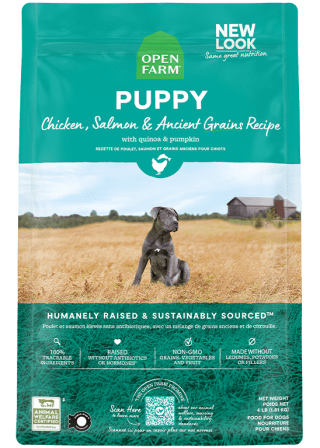
What we like
Good source of proteinVet nutritionists on staffCan be autoshipped
Open Farm comes recommended by Ostermeier for its fresh ingredients and high-protein formula. This option has a blend of fresh chicken, salmon and pork, which helps support healthy brain development, and ancient grains like steel-cut oats, millet, brown rice, quinoa and chia seeds, according to the brand. Open Farm’s dog food meets AAFCO’s nutritional standards and the brand has a team of veterinary nutritionists to formulate its dog food, according to Open Farm.
Food type: Dry | Recommended age: Up to 1 year old (small breed puppies), up to 2 years old (large breed puppies) | Recommended weight: Up to 100 lbs (expected adult weight) | Calorie content: n/a | Top ingredients: Chicken, whitefish meal, oats, salmon, millet, brown rice
Best tasting puppy food: Blue Buffalo Life Protection Formula Puppy Chicken & Brown Rice Dry Dog Food
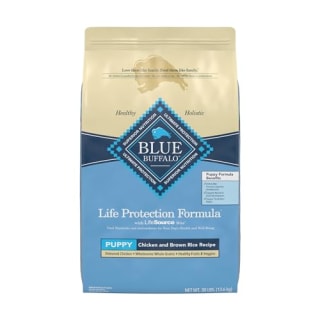
What we like
Supports immune systemSmall-sized kibbleDoesn’t irritate stomach
Something to note
Nothing to note at this time
Daruvuri housed her sister’s now 1-year-old cavapoo Joey for two months when he was a puppy, and fed him this Blue Buffalo kibble because her own dog Bandit used to eat it and never had any stomach issues. “Joey absolutely loved the taste of the kibble — it would always be gone about 10 seconds after I put down his bowl — so much so that I would also use it as an occasional training treat,” she says. Packed with vitamins, antioxidants and minerals like calcium and phosphorus, this formula helps support your puppy’s immune system health and comes in easy-to-eat puppy-sized kibble, according to the brand.
Food type: Dry | Recommended age: Up to 1 year old | Recommended weight: Up to 60 lbs | Calorie content: 401 kcal per cup | Top ingredients: Deboned chicken, chicken meal, brown rice
Best puppy food for sensitive stomachs: Hill’s Prescription Diet i/d Digestive Care Dry Dog Food
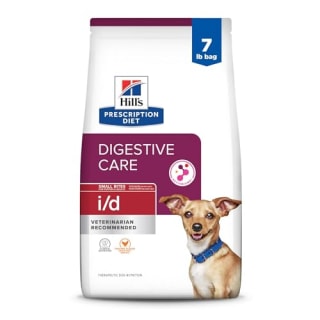
What we like
Regulates gut bacteriaHelps digestive issuesRegulates bowel movement
If your pup struggles with a sensitive stomach, this Hill’s prescription diet has a proprietary blend of ingredients, which the brand calls ActiveBiome+, to help regulate gut bacteria , as well as a prebiotic blend to help maintain regular bowel movements, according to Hill’s. It also has vitamin B and antioxidants to help replenish nutrients that were lost during their digestive issues, according to the brand. Keep in mind that you’ll need your veterinarian’s approval to purchase this food — you can request this prescription diet through Chewy’s site by providing your pet and vet clinic’s information.
Food type: Dry | Recommended age: All life stages | Recommended weight: Up to 120 lbs | Calorie content: 367 kcal per cup | Top ingredients: Brewers rice, whole grain corn, chicken meal, pea protein
How to shop for puppy food
When shopping for the best puppy food, start by asking your vet for their top choices, then reach out to trusted groomers and dog trainers. Generally, there are a few factors to consider when shopping for the right food for your puppy, including your dog’s size and breed, whether it meets AAFCO requirements, palatability and ingredients.
Meets AAFCO requirements
Dog food for all ages should meet AAFCO nutritional standards, meaning the food is nutritionally complete. AAFCO is a voluntary membership association of feed control officials that develop standards, definitions and policies for the sale and distribution of pet food, among other animal feeds. You should always look for the nutritional adequacy statement on the back label, which should include in small font the phrase “complete and balanced” to ensure it’s intended to make up your pup’s sole diet, according to our experts.
Keep in mind that AAFCO doesn’t regulate, test, approve or certify pet food, so there’s no such thing as an “AAFCO approved” brand or product.
Ingredients and palatability
“The food should be balanced for puppies (growth) or all life stages, which are foods that are considered supportive for puppyhood and adult maintenance,” says Ostermeier. Essential ingredients to look for in puppy food include proteins (like chicken, beef or fish), whole grains and vegetables, which provide the necessary nutrients for a growing puppy, says Dr. Abel Gonzalez, a veterinarian and the clinical director at Dutch, a pet telehealth company.
You should always ensure the puppy food brand employs veterinary nutritionists that develop nutritionally balanced and complete meals and regulate the food’s ingredients, according to our experts. (AAFCO has safety standards for ingredients used in pet food, and it goes in depth about common pet food labels.)
There are also a few ingredients to avoid: “Stay away from foods with excessive fillers (like corn and soy), artificial colors, flavors, or preservatives, which offer little nutritional value,” says Gonzalez.
Nutritional balance and portion size
Make sure to check the food’s packaging for specific feeding guidelines and energy density, shown as kcal (calories) per cup, can or ounce, which are similar to the nutritional facts on human foods. This makes sure you’re giving your puppy the appropriate nutrients and portions for their growth and development, according to our experts.
“Every brand is going to be slightly different with the calorie density and how much they recommend feeding the puppy,” says Savageau. “Whether you’re feeding your puppy three times a day or twice a day as they’re getting older, make sure the total amount they’re being fed matches what their total calories should be for the day based on the individual bag.”
Breed size and weight
Make sure the food’s label clearly states that it is made specifically for puppies or for all life stages, according to our experts. Breed- and size-specific formulas are great for large and giant breeds because they need a specific ratio of nutrients and minerals to prevent them from growing too quickly, says Savageau. (I go more in-depth about the benefits of puppy-specific formulas and what to feed large and giant breeds below).
Frequently asked questions
How many times should you feed your puppy?
How many times you feed your puppy throughout the day depends on their age. During the early phase of puppyhood, around 6 to 12 weeks of age, you should feed them at least three times per day, which helps maintain their energy levels and supports their fast metabolism, says Savageau. Once they’re 4-6 months old, you can transition to twice a day, she says. Large and giant breed puppies should get three meals per day until they’re about 6 months old, says Savageau.
However, due to their rapid growth during this time of life, your puppy may still be hungry after feeding them those 2-3 meals per day — this is especially true for puppies under 6 months of age whose growth and metabolism rates can vary day to day, says Ostermeier.
“If you feed your puppy their allotted meal portion and they still seem hungry, it is ok to give them extra food or an extra meal,” says Ostermeier. Signs that your puppy is still hungry could include sniffing or searching for food, crying or whining, pawing at you or trying to get your attention.
How much food should you give your puppy?
It’s best to check in with your veterinarian about the exact feeding amount or calories per day that you should be giving your puppy, says Ostermeier. If you’re feeding them a puppy-specific formula, you can follow the guidelines recommended by the dog food company. Most commercial puppy food has feeding guidelines based on weight on the back label or on the brand’s website, according to our experts.
Most importantly, puppies can easily become hypoglycemic if they aren’t receiving enough food.
“The main reason we want to feed more frequently when they’re younger is because they can become hypoglycemic quicker, so they’re blood glucose level can drop,” says Savageau.
If your puppy ever appears weak or “drunk,” this could be a sign of hypoglycemia and you’ll need to feed them as soon as possible and call your veterinarian, says Ostermeier.
At what age should you switch from puppy to adult dog food?
Switching from a puppy-specific diet to adult dog food depends on your dog’s breed and size. “The appropriate time to change to adult food is generally anywhere from 6 months to 14 months,” says Ostermeier.
Large to giant breed dogs should usually take longer to transition so they don’t grow as quickly. They typically need to switch after 1 year and even up to 2 years for giant breeds, says Savageau. Since that’s a wide range, all of our experts recommend consulting with your veterinarian on when it is best to switch your dog to adult food, especially for giant breeds.
Kibble versus canned: Which type of food is best for your puppy?
Dry food is more economical and typically more stable if stored in a cool, dry environment compared to wet food, which goes bad at room temperature after opening, according to our experts. But the main difference between dry kibble and canned dog food comes down to water content: Kibble is typically made up of 10% water, while canned food has upwards of 70% water, experts told us in our guide to dog food.
All of our experts suggest combining your puppy’s dry food with their canned wet food or other moisture-rich foods, especially if they’re picky eaters or need an extra boost of hydration.
“Feeding a combination diet that includes moist options such as fresh, gently cooked food or a quality canned food increases the moisture of the diet and aids in hydrating the animal,” says Ostermeier. This includes adding fresh, dog-safe vegetables and fruits to their meals to add nutritional value without adding the calories as long as they’re still getting their normal kibble (more about toppers below). “Moist foods, especially fresh or gently cooked options, are [also] very minimally processed,” says Ostermeier.
Ostermeier doesn’t recommend feeding your pup 100% dry kibble meals. “Dry kibble was created to provide convenient, balanced meals for dogs. TV dinners were created to do that same thing for humans,” she says. “In my opinion, processed food as part of the diet is okay, but it doesn’t make sense for any living being to eat processed food all the time because it just isn’t the healthiest option.”
Do you need toppers and supplements?
While most puppies don’t need supplements if they’re on a balanced diet, underweight puppies or those with health conditions might require them, according to Gonzalez. Morgan recommends adding organic toppers like pumpkin, eggs or blueberries to your pup’s kibble. “These toppers boost the immune system and provide fresh vitamins, [but] should not make up more than about 15% of the meal,” she says.
You can also consider adding a probiotic supplement to boost your pup’s gut health. “They will be going through the stress of weaning, moving to a new environment and having a new ‘pack’ of family members,” says Morgan. “Good gut health helps them navigate this stress more easily and helps avoid bouts of [gastrointestinal] upset.”
Are raw diets bad for your puppy?
All of our experts advise against feeding your puppy a raw diet. “Raw diets can be risky for puppies due to potential bacteria and nutritional imbalances,” says Gonzalez. Just like humans, the potential for contamination puts dogs at a greater risk of getting bacterial infections like salmonella or E. coli, and especially puppies who have a weaker immune system, according to Savageau. Also, because harmful parasites and bacteria can contaminate raw diets, your dog may transmit them to you and your family, too, she says.
Are grain-free diets better for your puppy?
No, a grain-free diet (which means the dog food is made without wheat, rye, corn and barley) is not better for your puppy. Unless your puppy has a gluten intolerance, or a grain-free diet is specifically recommended by their veterinarian, it’s not necessary to give your puppy grain-free food, according to our experts.
In fact, grain-free diets are commonly associated with certain heart diseases if not carefully balanced, so you’ll need to discuss any diet change with a vet, says Savageau. Feeding your pup grain-free kibble can sometimes prevent them from getting their appropriate daily nutritional intake, experts say.
Can puppies be allergic to certain foods?
It is very rare that puppies have food allergies — in fact, allergies in dogs typically develop over time due to prolonged exposure to certain ingredients, especially proteins like chicken and beef, says Savageau. “Dog owners will often say, ‘Well, I’ve been feeding him the same diet his whole life, there’s no way he could be reacting to it’ — well that’s the exact reason why he could be reacting to it,” she says.
The most typical signs of an allergy for dogs of all life stages include constantly itching, licking their paws and getting ear infections, says Savageau. However, these signs are more likely due to environmental allergies than food reactions, says Savageau. Even gastrointestinal issues like diarrhea in puppies are more likely to be due to other factors (like parasites) than related to their diet, says Savageau.
Meet our experts
At NBC Select, we work with experts who have specialized knowledge and authority based on relevant training and/or experience. We also take steps to ensure all expert advice and recommendations are made independently and without undisclosed financial conflicts of interest.
Dr. Nell Ostermeier is a veterinarian and veterinary advisor at Figo Pet Insurance.Dr. Nicole Savageau is a board-certified veterinarian at The Vets, a mobile veterinary service.Dr. Abel Gonzalez is a veterinarian and the clinical director at Dutch, a pet telehealth company.
Why trust NBC Select?
I am an updates editor at NBC Select who covers a variety of pet topics, including dog food, beds, treats and toys. For this article, I spoke to three veterinarians about the best dog food brands for your puppy and what you need to know when shopping for one. She also compiled their recommendations for the best puppy food brands to consider and researched dozens of options on the market based on expert guidance.
Catch up on NBC Select’s in-depth coverage of personal finance, tech and tools, wellness and more, and follow us on Facebook, Instagram, Twitter and TikTok to stay up to date.

